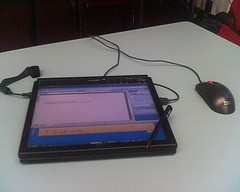Tablet Splitting: Inconsistent and Potentially Dangerous: used tablet pc
Healthcare providers and patients frequently split tablets for a number of reasons. Chiefly, tablet splitting is used to (a) make the tablets easier to swallow, (b) adjust the dosage or c) reduce the cost (for example, a 90-day supply is split will last six months). But a new study reports that tablet splitting is potentially dangerous because it produces a wide variability in the dosage the patient actually receives.
Pharmaceutical scientist Charlotte Verrue and colleagues of Ghent University in Berlin to measure how much the tablet weight differs from its expected weight when split by different individuals and how much of the tablet is lost when the tablet is split into unusable fragments. Five volunteers were given eight commercially available tablets of different sizes and shapes that are routinely found in nursing homes.
They drugs included Marevan (warfarin), Lanoxin (digoxin), and Sinemet (Levodopa and carbidopa) and Metformin (metformin). Of the different tablet types, three had one score down the middle, two had two scores like a cross, and three were unscored. Volunteers were asked to split the tablets using different routinely used methods: a commercial tablet cutter, by hand for prescored tablets, by scissors for unscored tablets, or by kitchen knife. Before and after splitting each tablet and its subsequent fragments were weighed.
Verrue found that nearly a third of all tablets sliced by any method investigated varied by more than 15% from the prescribed dose. Using the tablet cutter was most accurate, but 26.5% of the tablet fragments produced were off by more than 15%. The kitchen knife was the worst. Thirty-three percent of all tablets slice by kitchen knife were off by more than 15%.
Splitting with the tablet cutter also resulted in significantly less weight loss from the tablet than the other methods. For example, using the cutter resulted in 1.56+/- 2.48% loss in total tablet weight compared with 2.36+/-4.36 for scissors or by hand, and 3.42+/-4.55% using the kitchen knife. The maximum percentage of tablet loss by each method was 26%, 36%, and 37% respectively.
In some cases, these significant deviations from the expected dose that occur during tablet splitting are not a problem. For example, there are some chronic therapies where a patient takes the drug daily and it doesn't matter if they receive a little more or a little less each day. Tablet splitting becomes dangerous when it is important that a patient receives the exact same dose everyday.
Moreover, some medications have a very small window between when the dose is beneficial and when it becomes toxic. If the dose that patients receives varies even slightly because of inaccuracies in tablet splitting, a patient could be severely harmed.
To protect patients, Veurre and colleagues suggest that pharmaceutical companies market smaller doses of their drugs so that patients don't have to split them. However, if patients still wish to split their tablets, they should be warned that not all tablets can be split safely.
It's best to ask a pharmacist or a physician before splitting tablets so that they can alert patients to any potential risks. Finally, according to the results of Veurre's study patients should use tablet-cutting devices because they are more accurate.
To find out more information about clinical trials or how to join a clinical trial please visit our website.
Article Source:
http://EzineArticles.com/?expert=Aubrey_Clark
Used Tablet Pc Videos
Tablet PC - MobileDemand presents the xTablet rugged handheld tablet PC computer, demonstrating the key features, development and testing methods used in the xTablet T8600 and T8700. Brought to you by MobileDemand - www.ruggedtabletpc.com . The xTablet rugged Tablet PC can withstand harsh environents when used as a work "tool". Over 2000 of the xTablet rugged Tablet PCs are used and mounted in beer trucks across America! The xTablet rugged Tablet PC does it's part in getting the beer to your fridge!

Check out our quality assurance video at the Acura Embedded Systems channel.
ReplyDelete